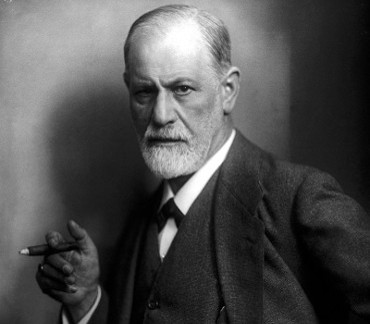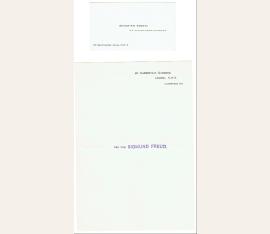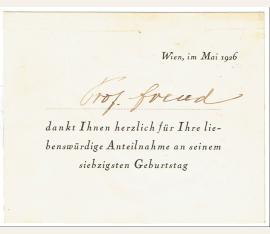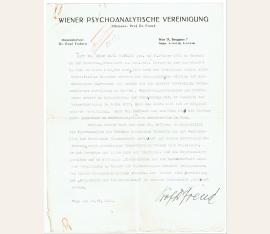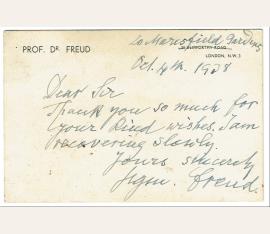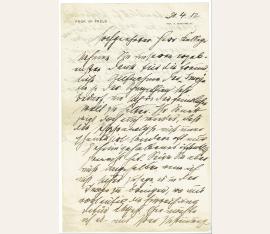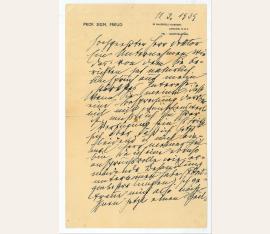physician, founder of psychoanalysis, (1856-1939). His personal visiting card. London. 32mo. 1 p.
$ 2,680 / 2.500 €
(61448)
Freud’s personal visiting card with his first address in London. Freud was living at this address only for three months. - Visitenkarte mit Freuds erster Adresse in London. Freud wohnte nach seiner Emigration nur drei Monate in der Elsworthy Road, da der Mietvertrag nicht verlängert werden konnte. Beilage: Blatt mit Adresse: 20 Maresfield Gardens, London NW 3 mit Stempel: "Per pro Sigmund Freud". Hier handelt es sich um Freuds zweite Adresse in London. Das Haus, das von der Familie bis zum Tod von Anna Freud 1982 bewohnt wurde, ist heute Sitz des Freud Museums London.
Mediziner und Begründer der Psychoanalyse (1856–1939). Gedr. Karte mit eigenh. Unterschrift „Prof. Freud“. Wien. Quer-8vo. 1 p. Mit ms. Kuvert.
$ 3,752 / 3.500 €
(81793)
Gedruckte Danksagungskarte zu Freuds 70. Geburtstag adressiert an Gabriele Gräfin von Wilczek. Rückseitig Montagerückstände auf der Karte und dem Briefkuvert.
Mediziner und Begründer der Psychoanalyse (1856-1939). Ms. Zeugnis mit eigenh. Unterschrift. Wien. Gr.-4to. 1 p. Gedr. Briefkopf „Wiener Psychoanalytische Vereinigung | Obmann: Prof. Dr. Freud“. Gefaltet. Klammerspuren.
$ 8,040 / 7.500 €
(91801)
Zeugnis: „Herr Dr. ERNST PAUL HOFFMANN geb. am 23. Jänner 1891 in Radautz in der Bukowina, provoviert zum med. univ. Doctor an der Universität in Wien im Jahre 1914, hat sich, bald nach der Beendigung seines militärärztlichen Dienstes während der Kriegsjahr dem Studium der Psychoanalyse zugewndet und machte die von unserer Vereinigung vorgeschriebene Ausbildung in Kursen, Seminaren, Lehranalyse und praktischer Arbeit am Ambulatorium der Vereinigung mit. Er beendete den Unterrichtsgang im Jahre 1927.
Seit dem Jahre 1926 ist er Mitglied unserer Verinigung. Herr Dr. Hoffmann war von März 1933 bis Februar 1937 Assistent am Psychoanalytischen Ambulatorium in Wien. […]“ Hoffmann begann 1922 seine Lehranalyse bei Paul Federn und bei Eduard Hitschmann und arbeitete 1924 bis 1937 als Sekundararzt und Assistent am Psychoanalytischen Ambulatorium der Wiener Psychoanalytischen Vereinigung, in die er 1926 als außerordentliches und 1931 als Vollmitglied aufgenommen wurde. 1936 hielt er die Vorlesung Einführung in die Psychoanalyse am Wiener Psychoanalytischen Lehrinstitut.Ab 1927 betrieb er eine private psychoanalytische Praxis im 6. Bezirk in Wien. Nach dem Anschluss Österreichs 1938 emigrierte er mit seiner Familie nach Belgien. Dort war er Lehranalytiker der späteren Gründer der Association des Psychanalystes de Belgique (APB). Das Affidavit der American Psychological Association für die USA erhielt er erst, als die Deutschen 1940 Belgien überfielen. Diese inhaftierten ihn für mehrere Monate im Lager in Saint-Cyprien in Südfrankreich. Von dort wurde er in das Camp de Gurs überstellt. Eine Möglichkeit nach Kuba auszureisen, schlug er aus, da seine Familie noch in Belgien festhalten wurde. 1941 wurde er in das Lager Les Milles verlegt, aus dem er 1942 zu Freunden nach Marseille fliehen konnte. Diese brachten ihn über die Schweizer Grenze, wo er in einem Flüchtlingslager bei Lausanne untergebracht wurde. Hoffmann hatte sich in der Gefangenschaft ein Magenleiden zugezogen und verstarb im Dezember 1944 bei einer Operation..
Austrian neurologist and founder of psychoanalysis (1856-1939). Autograph Letter Signed, 'Sigm. Freud'. 20 Maresfield Gardens, London, NW3. Oblong-small 8vo. 1 p. 90 x 135 mm. A little dust-soiled, verso blank.
$ 5,146 / 4.800 €
(92042)
In blue ink on a personalised notecard, thanking the unknown recipient 'so much for your kind wishes. I am recovering slowly'. Freud arrived in London in June 1938 and after spending a short period in a flat at 39 Elsworthy Road in Primrose Hill (this address struck through on the notecard), he and his family moved in September to 20 Maresfield Gardens in Hampstead. He was to die of cancer the following September and the house is now the home of the Freud Museum.
Mediziner und Begründer der Psychoanalyse (1856-1939). Autograph letter signed „Freud“. Wien. 8vo. 1 1/2 pp. Gedr. Briefkopf.
$ 13,400 / 12.500 €
(92068)
Handwritten letter to the medical doctor, writer and poet Hugo Salus, in part (translated): "Accept our most sincere thanks for the kind reception of 'Imago,' which indeed requires sympathy to sustain itself in the hostile world. Your sonnet also once again shows that psychoanalysis does not always fantasize but often only discloses what was kept secret. However, please do not be displeased if I do not firmly commit to publishing it in Imago, where we currently lack the space for it. Rather, with your consent, I would prefer to transfer it to the Zentralblatt für Psychoanalyse, which has been paying attention to confirmations of our propositions in poetic works for some time.
As you know, it is the same publisher as Imago." In fine condition, with a short split to the central horizontal fold. Accompanied by an export certificate from the French Ministry of Culture. A significant letter by Dr. Freud, acknowledging the adoption of his psychoanalytic practices by members of the arts community. In 1912, Salus's sonnet 'Der Knabe' appeared in No. 12 of the Zentralblatt für Psychanalyse und Psychotherapie, a publication co-edited by Sigmund Freud..
Mediziner und Begründer der Psychoanalyse (1856-1939). Eigenhändiger Brief mit Unterschrift. Wien, IX. Berggasse 19. Gr.-4to. 1 1/3 pp. Gedr. Briefkopf. Faltspuren.
$ 30,016 / 28.000 €
(93329)
Großer Brief an den Psychoanalytiker Paul Federn (1871-1950): „Sehr stolz auf die zauberhafte Wirkung meines Mahnschreibens bitte ich mir zu bestätigen, daß ich mich bisher als der eifrigste Kämpfer für das Ansehen der Zentrale verhalten habe. Ich weiß warum ich das thue, u. ahne auch warum sich die Opposition innerhalb der PA [Psychoanalyse] gerade gegen die Vereinsbildung richtet. Von meinem Briefwechsel mit Bleuler werden Sie schon gehört haben. Ich glaube, daß unsere Beziehungen sonst ungeändert bleiben werden.
Er wird fortfahren mich zu beschützen und zu kritisiren. Wahrlich der Mann war der richtige der Amtswesenz zu geben. Hoffentlich haben Sie zur Bearbeitung der kathol. Kirche ähnlich gute persönliche Legitimation. Wenn nicht Zensurrücksichten beim Verleger die Oberhand behalten, möchte ich Ihnen das graue wie neues Bändchen für die ,Schriften’ abnehmen. Meine abscheulichen Zahnschmerzen haben mir zwar den Abendbesuch in Ihrem Haus arg gestört erweisen sich aber machtlos gegen die purifizirte Erinnerung daran. Grüßen Sie mir Ihre liebe Frau herzlich u nehmen Sie selbst die besten Grüße von Ihrem Freud“.
Mediziner und Begründer der Psychoanalyse (1856-1939). Eigenh. Brief mit U. ("Sigm. Freud"). Wohl London. 1½ SS. 8vo.
$ 13,400 / 12.500 €
(91387/BN60442)
An einen "hochgeehrten Herrn Doktor" über die gesundheitlich bedingte Unmöglichkeit, eine Besprechung zu verfassen: "Ein Unternehmen wie das, von dem Sie berichten, hat natürlich Anspruch auf mein stärkstes Interesse. Wenn Sie meinen, daß eine Besprechung darüber mit mir wünschenswert ist, müßte ich zu Ihrer Verfügung sein. Es trifft sich aber daß ich jetzt leidend u. nicht einmal Herr meiner Zeit bin, da ich eine ebenso anspruchsvolle wie ermüdende Behandlung unternommen habe (Röntgenbestra[h]lungen).
Ich getraue mich also nicht Ihnen jetzt einen Zeitpunkt für Ihren freundlichen Besuch anzugeben. Sollten Sie später Ihre Absicht wieder aufnehmen, so bin ich dann vielleicht in der Lage, Sie bei mir zu sehen [...]". - Freud war bereits 1923 nach seiner Gaumenoperation mit Röntgenstrahlen behandelt worden, weitere Behandlungen folgten 1930, 1931 und 1934. Ab Februar 1939 wurde er dann in London u. a. von Neville Finzi, einem der führenden Röntgenologen Großbritanniens, behandelt. Nach mehreren Sitzungen diagnostizierte im Mai der Oralchirurg George Exner, der u. a. in Wien bei dem Kieferchirurgen Hans Pichler studiert hatte, "erneute Krebsrezidive, hält eine Operation aber nicht mehr für angezeigt. Es wurde Radium mit Hilfe einer Prothese 2 Stunden pro Tag gegeben, daneben tiefe Röntgenbestrahlung. Die Geschwulst ist zurückgegangen, aber Metastasen sind aufgetreten". Im Juli und August bemerkte Freuds Leibarzt Max Schur verdächtige Läsionen in Freuds Mundhöhle und konnte Pichler, der Freuds Gaumenkrebs zwischen 1923 bis 1936 schon mehr als 30-mal operiert hatte, dazu überreden, persönlich nach London zu kommen und Freud zu untersuchen. Pichler traf am 7. September in London ein und stellte in einer gleich darauf anschließenden Untersuchung fest, daß operiert werden müsse. Die Operation am Tag darauf überstand Freud gut, den ganzen Monat jedoch sollte er nicht mehr erleben. - Auf Briefpapier mit gedr. Briefkopf; stellenweise gering fleckig und mit zwei kleinen alt hinterlegten Einrissen im Mittelfalz..
sold
E. Brief mit U.
Autograph ist nicht mehr verfügbar
Sigmund Freud (1856–1939), Mediziner und Begründer der Psychoanalyse. E. Brief mit U. („Freud“). Wien, 16. Juni 1925. ¾ S. 8°. – Wohl an Arthur Schnitzler: „Montag 29 dM paßt mir sehr, es ist der letzte Tag, den ich vor dem Sommerurlaub in Wien zubringe. Ich kann Dich um 3h pM empfangen wenn Dir ein zerstörtes Zimmer nichts macht [...]“. – Auf Briefpapier mit gedr. Briefkopf.
E. Brief mit U.
Autograph ist nicht mehr verfügbar
Sigmund Freud (1856–1939), Mediziner und Begründer der Psychoanalyse. E. Brief mit U. („Freud“). Wien, 10. Januar 1930. ¾ S. Gr.-8°. Mit einigen Beilagen (s. u.). – An die Schriftstellerin und Journalistin Helene Scheu-Riesz (1880–1970), die ihm am Tag zuvor einen Brief des amerikanischen Dichters Robert Haven Schauffler hatte zukommen lassen, der eine Frage enthielte, „die nur Sie selber beantworten können. Sein Buch hat auf mich einen so tiefen Eindruck gemacht, [...] und die Frage, inwieweit psychische Beeinflussung in einem bestimmten Sinn durch Dichtung möglich ist, beschäftigt mich sehr stark. Wollen Sie erlauben, dass Mr. Schauffler Ihnen sein Buch bringt? Er ist ein Mann von so ungewöhnlichen Qualitäten, dass nicht einmal Sie es bedauern werden, ihm ein Stückchen Ihrer kostbaren Einsamkeit geopfert zu haben [...]“ (ms. Brief v. 9. Januar 1930; hier als Durchschlag beiliegend). Freud nun schreibt ihr unterm 10. des Monats: „Ich gebe zu daß Herr Schauffler infolge Ihrer Empfehlung und seiner Beziehung zu G. St. Hall [d. i. der amerikanische Psychologe Granville Stanley Hall, 1844–1924] einen besonderen Anspruch darauf hat daß sein Wunsch etwas mit mir zu besprechen erfüllt werde. Aber mein großes Ruhebedürfnis – nicht der Wert meiner Zeit – steht dem im Wege [...]“. – Helene Scheu-Riesz wurde bekannt als Lyrikerin und Erzählerin für die Jugend, gab unter dem Titel „Sesam-Bücher“ in dem von ihr gegründeten gleichnamigen Verlag eine Klassiker Sammlung heraus und verfaßte Märchenbücher, Puppen- und Weihnachtsspiele; zudem war sie in der österreichischen Frauenbewegung und Kinderpädagogik tätig. 1934 in die USA emigrierend, lebte sie als Journalistin in New York und kehrte 1954 nach Wien zurück. Das erklärte Ziel der Gattin des sozialdemokratischen Politikers Robert Scheu war es, eine Universalbibliothek mit „guter“ Literatur für alle, insbesondere auch für ärmere Kinder zu schaffen. – Auf Briefpapier mit gedr. Briefkopf.
E. Postkarte mit U.
Autograph ist nicht mehr verfügbar
Sigmund Freud (1856–1939), Mediziner und Begründer der Psychoanalyse. E. Postkarte mit U. („Freud“). [London], 14. Juni 1938. 2 SS. Qu.-8°. – Kurz nach seinem Eintreffen im Londoner Exil geschrieben und an einen gleichfalls emigrierten, namentlich nicht genannten Kollegen: „Dank für Ihre so freundliche Begrüßung! Ich werde mich sehr freuen, Sie zu sehen, nur daß es infolge meiner verschiedenen Infirmitäten nicht gut in Ihrem Hause sein kann. Man sagt mir, daß Sie sehr beschäftigt sind. Ich freue mich, daß Sie in der neuen Heimat den verdienten Erfolg gefunden haben und hoffe, Sie finden auch einmal Zeit für ein Plauderstündchen mit mir [...]“. – Der Briefkopf mit Freuds Namen und seiner Wiener Adresse und e. überschrieben mit seiner aktuellen, „39 Elsworthy Road, NW 3“. Freud war am 6. Juni in London eingetroffen und bezog zunächst ein gemietetes Haus an der Elsworthy Road, während sein Sohn Ernst und seine Haushälterin Paula Fichtl für ihn seinen Arbeitsraum in 20 Maresfield Gardens rekonstruierten.
E. Notiz mit U.
Autograph ist nicht mehr verfügbar
Sigmund Freud (1856–1939), Mediziner und Begründer der Psychoanalyse. E. Notiz mit U. [Wien], 3. Januar 1930. 1 S. Qu.-kl.-8°. – „Mit herzlichem Dank und guten Neujahrswünschen | Freud“. – Auf Briefpapier mit gedr. Briefkopf; alt auf Trägerkarton montiert und etwas fleckig bzw. gewellt.
Gehstock
Autograph ist nicht mehr verfügbar
[Sigmund Freud]. A late 19th- / early 20th century Austrian malacca cane with curved, silvered-metal handle impressed with diamond-pattern decoration, stamed mark of ‚O’ within diamond-shaped cartouche (handle dented, a little tarnished, plating rubber, later rubber ferrule). Provenance: Sigmund Freud (by repute; by descent to Freud’s son) – Jean Martin Freud (1889-1967, to his partner, F. M. Freud; a gift from her to the vendor). A cane said to be Freud’s, formerly the property of Martin Freud, and his partner Margaret Freud. From the property of Margaret Freud, given by her to the vendor, neighbour and friend.
Eigenh. Notiz mit U.
Autograph ist nicht mehr verfügbar
On a four-page letter, addressed to Freud by "Alexander Stiglitz, Rožnava [Rosenau], Slovensko. C. S. R" (Eastern Slovakia) and dated November 20, 1933. Stiglitz describes some cases of stammering that occurred in his family and asks whether and under which circumstances a treatment of his brother might be possible: "I note that my father also began to stammer when he was 11, after falling on his head from a height of about eight feet; the impediment now concerns almost exclusively the sound K. His bother would stammer for some time, apparently without reason, but this ceased at age 19. In the case of my brother, the impediment worsened, especially in the last two years. At the moment, the spasmodically gaping mouth is highly characteristic. He stammers at every sound, most strongly probably at the labials M, P, F (but also A), somewhat less so at the gutturals. It distresses him; he becomes nervous, irritable, perspires. (Body weight 53 kgs, height 168 cm.) He works at my father's inn (with the elder brother) [...]". - Under Stiglitz's letter, Freud noted "Zur gefälligen Beantwort[un]g | 10/XII | Ihr Freud", leaving the reply to Paul Federn.
Kabinettphotographie mit eigenh. U. ("Sigm. Freud").
Autograph ist nicht mehr verfügbar
The classic photograph of Freud with cigar in hand, taken by his son-in-law, the photographer Max Halberstadt. - With the blind stamp of Max Halberstadt, Hamburg, on the mount; signed by Freud across the mount; mount browned and starting to chip. - Provenance: Acquired from Dr Robert Riggall of Northumberland House, a private mental asylum in north London, by a colleague, thence by family descent.
Eigenh. Brief mit U.
Autograph ist nicht mehr verfügbar
To Gilbert Perleberg from the Federation of the German Yorek Movement in New York. Freud states his great interest for the explanations of Hans Moser in the "Rundbrief" (circular), and is pleased to see that psychoanalysis arouses interest in this certain circle. Nevertheless Freud means to have found some mistakes in the essay, as he does not believe the problem of conscience holds a central position in his works. - On stationery with printed letterhead.
Portraitdruck mit eigenh. Unterschrift „Sigm. Freud | 1932“.
Autograph ist nicht mehr verfügbar
Autograph signature ("Sigm. Freud").
Autograph ist nicht mehr verfügbar
